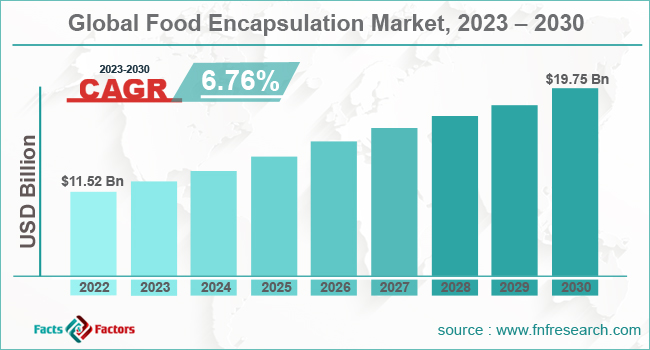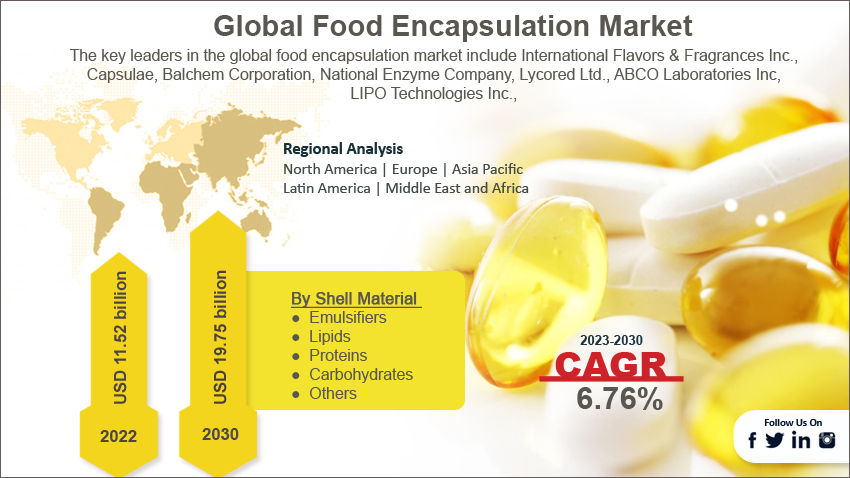Search Market Research Report
Food Encapsulation Market Size, Share Global Analysis Report, 2023 – 2030

Food Encapsulation Market Size, Share, Growth Analysis Report By Shell Material (Emulsifiers, Lipids, Proteins, Carbohydrates, And Others), By Technology (Physical Processes, And Chemical Or Physicochemical Processes), By Core Phase (Essential Oils, Probiotics, Prebiotics, Colors, Sweeteners, Preservatives, Essences, Enzymes, Minerals, Organic Acids, And Vitamins), By Type (Macro Encapsulation, Hybrid Technology Nanoencapsulation, And Microencapsulation), And By Region - Global and Regional Industry Insights, Overview, Comprehensive Analysis, Trends, Statistical Research, Market Intelligence, Historical Data and Forecast 2023 – 2030
Industry Insights
[221+ Pages Report] According to the report published by Facts & Factors, the global food encapsulation market size was USD 11.52 billion in 2022 and is expected to surpass USD 19.75 billion by the end of 2030. The market is likely to grow with a CAGR of 6.76% during the predicted period. The global food encapsulation market report covers all aspects, including the potential growth drivers, restraints, and leading market players. Also, it offers detailed key insights into the opportunities and challenges in the market landscape. The report also explores market segmentation and regional developments in the food encapsulation industry.

 Market Overview
Market Overview
Food encapsulation is the process of enclosing the food ingredients within the protective shell or matrix. This technique is widely utilized to enhance the functionality, shelf life, and stability of food ingredients like nutrients, colors, flavors, or bioactive compounds. It offers numerous benefits like masking odors, unwanted tastes, protection from degradation, controlled release, and targeted delivery of specific ingredients. The encapsulation process includes various steps like selection & preparation of encapsulating material, encapsulation of food components, and solidification.
 Key Insights
Key Insights
- As per the analysis shared by our research analyst, the global food encapsulation market size is estimated to grow annually at a CAGR of around 6.76% over the forecast period (2023-2030).
- In terms of revenue, the global food encapsulation market size was valued at around USD 11.52 billion in 2022 and is projected to reach USD 19.75 billion by 2030.
- The high demand for dietary supplements is likely to drive the growth of the global food encapsulation market.
- Based on the shell material, the carbohydrate segment accounts for the largest share of the global market.
- Based on the technology, the physical process segment holds the largest share of the global market.
- Based on the core phase, the vitamin segment is expected to lead the market.
- Based on the type, the microencapsulation segment is expected to dominate the global market.
- Based on region, North America is expected to dominate the market during the forecast period.

 Growth Drivers
Growth Drivers
- High demand for dietary supplements is likely to boost the growth of the global market.
The quick shift of customer preferences towards preventive healthcare management is likely to significantly increase the demand for dietary supplements in the market. The major reason behind the wide adoption of preventive healthcare management is the high incidences of lifestyle diseases along with rising healthcare costs. Therefore, people include more dietary supplements like omega 3, minerals, vitamins, enzymes, etc., to maintain their health which in turn is expected to propel the growth of the global food encapsulation market during the forecast period.
There are certain important ingredients that are difficult to gain through the food we eat and absorb equally by the human body. Consequently, there is a big requirement to fill those essential ingredients in the body with the help of some supplements to meet the daily nutritional requirement. Encapsulation plays a major role in fulfilling the surging demand for such supplements by maintaining the nutrition, color, and taste of the product throughout for longer shelf life. Additionally, people are inclining more toward clean labeled food items and natural flavors, which is further likely to foster developments in the global market during the predicted period. Also, the hectic lifestyle of people is forcing them to opt for a variety of convenience and fortified food. Manufacturers have raised attention to the quality of the products, their natural origin, safety, and the long shelf life of the items.
 Restraints
Restraints
- A high inclination rate towards traditional preservation techniques is likely to restrict the growth of the global market.
Small and medium-sized organizations are adopting the traditional techniques of preservation instead of encapsulation owing to the fact that it is quite expensive. Furthermore, several new markets are coming up, particularly in the functional food sector, to meet the surging demand along with the low cost of production. Encapsulation incurs some extra costs, which are not accepted by all manufacturers. Therefore, it is expected to hamper the growth of the global food encapsulation industry significantly during the forecast period.
 Opportunities
Opportunities
- Increasing bioavailability and decreasing capsule size are expected to offer liberating growth opportunities in the global market.
The size of nanocapsules ranges from around 1 to 100 nm. This site is assumed perfect for encapsulating highly potent bioactives along with assuring 100% targeted delivery. The best-suited size for the dietary supplement is 1-100, which can hold up to 290 to 850 mg of material. These are best used for granulated and powdered substances. Also, the small capsule size is good for antioxidants, fat-soluble vitamins, minerals, etc. Therefore, such a landscape is likely to offer lucrative growth opportunities in the global food encapsulation market.
 Challenges
Challenges
- Poor production efficiency, along with ingredient incompatibility, is a big challenge in the global market.
Scaling up the production activity to the commercial level is quite challenging because it is difficult to maintain the consistency encapsulation regarding product stability and quality at a large scale. Such a landscape requires a significant investment in expertise, technology, and equipment which is a big challenge in the global food encapsulation industry.
Also, the major purpose of encapsulation is to protect the reactive ingredients from degradation, but achieving high quality with long-term stability is a challenge. Sometimes, the encapsulated ingredients undergo a reaction in the product's bioavailability, flavor, and texture over time. Therefore, searching out different encapsulation materials to offer the best protection to unique ingredients according to their characteristics is a big challenge, which is expected to slow down the growth of the global market.
 Segmentation Analysis
Segmentation Analysis
The global food encapsulation market can be segmented into shell material, technology, core phase, type, and region.
On the basis of shell material, the market can be segmented into emulsifiers, lipids, proteins, carbohydrates, and others. The carbohydrate segment accounts for the largest share of the global market due to its ability to offer protective matrices around the encapsulated ingredients. It helps in protecting sensitive ingredients, controlling their released properties, and offers stabilities in different environmental conditions.
On the basis of technology, the food encapsulation industry can be segmented into physical processes and chemical or physicochemical processes. The physical process segment holds the largest share of the global market. However, the chemical process segment is likely to grow significantly during the forecast period owing to its advanced technology and associated benefits.
On the basis of the core phase, the market can be segmented into essential oils, probiotics, prebiotics, colors, sweeteners, preservatives, essences, enzymes, minerals, organic acids, and vitamins. The vitamin segment is expected to lead the market during the forecast period due to the growing demand for fat-soluble vitamins in the food industry. Also, the growing interest of consumers in their health and wellness will positively shape the trajectory of the global market during the predicted period.
On the basis of type, the market can be segmented into macro encapsulation, hybrid technology nanoencapsulation, and microencapsulation. The microencapsulation segment is expected to see significant growth with a high CAGR during the forecast period.
 Report Scope
Report Scope
Report Attribute |
Details |
Market Size in 2022 |
USD 11.52 Billion |
Projected Market Size in 2030 |
USD 19.75 Billion |
CAGR Growth Rate |
6.76% CAGR |
Base Year |
2022 |
Forecast Years |
2023-2030 |
Key Market Players |
International Flavors & Fragrances Inc., Capsulae, Balchem Corporation, National Enzyme Company, Lycored Ltd., ABCO Laboratories Inc, LIPO Technologies Inc., Bionutrition Corp, Sensient Technologies Corporation, Symrise AG, Frieslandcampina Kievit, and others. |
Key Segment |
By Shell Material, Technology, Core Phase, By Type and Region |
Major Regions Covered |
North America, Europe, Asia Pacific, Latin America, and the Middle East &, Africa |
Purchase Options |
Request customized purchase options to meet your research needs. Explore purchase options |
 Regional Analysis
Regional Analysis
- North America holds the largest share of the global market.
North America accounts for the largest share of the global food encapsulation market due to the rising health awareness among people, along with the growing expenditure on preventive healthcare management. Also, the wide-scale promotion of nutrition and functional foods is further likely to propel the growth rate of the regional market during the forecast period.
The ongoing technological advancements in the region, like centrifugal exclusion, inclusive complex, and liposome compression, are also boosting the demand for fortified and functional food, which requires an encapsulation process, thereby fostering developments in the regional market in the forthcoming years.
Additionally, the high influx of on-the-go snacking in the region will further drive the growth of the market. Also, the busy lifestyle and the increasing challenges of meal preparation are forcing people to check out quick snacks with high nutritional value. Therefore, such a landscape is propelling the demand for encapsulated food that can be easily consumed and digested.
Asia Pacific is another leading region in the global food encapsulation market due to the increasing per capita income of the people along with their living standards. Additionally, the busy and fast-paced lifestyle of the people in the region is further encouraging them to opt for on-the-go snacking. The constantly growing population is another major factor positively impacting the growth of the regional market during the forecast period.
Europe is also likely to see significant growth in the global market due to the presence of strong market players in the region. Companies are coming up with advanced products to meet the surging demand. Also, the ongoing product launches, along with various collaboration and acquisition activities, will further positively impact the growth trajectory of the regional market.
 Competitive Analysis
Competitive Analysis
- International Flavors & Fragrances Inc.
- Capsulae
- Balchem Corporation
- National Enzyme Company
- Lycored Ltd.
- ABCO Laboratories Inc
- LIPO Technologies Inc.
- Bionutrition Corp
- Sensient Technologies Corporation
- Symrise AG
- Frieslandcampina Kievit
The global food encapsulation market is segmented as follows:
 By Shell Material Segment Analysis
By Shell Material Segment Analysis
- Emulsifiers
- Lipids
- Proteins
- Carbohydrates
- Others
 By Technology Segment Analysis
By Technology Segment Analysis
- Physical Processes
- Chemical Or Physicochemical Processes
 By Core Phase Segment Analysis
By Core Phase Segment Analysis
- Essential Oils
- Probiotics
- Prebiotics
- Colors
- Sweeteners
- Preservatives
- Essences
- Enzymes
- Minerals
- Organic Acids
- Vitamins
 By Type Segment Analysis
By Type Segment Analysis
- Macro Encapsulation
- Hybrid Technology
- Nanoencapsulation
- Microencapsulation
 By Regional Segment Analysis
By Regional Segment Analysis
- North America
- The U.S.
- Canada
- Mexico
- Europe
- France
- The UK
- Spain
- Germany
- Italy
- Rest of Europe
- Asia Pacific
- China
- Japan
- India
- Australia
- Southeast Asia
- Rest of Asia Pacific
- The Middle East & Africa
- Saudi Arabia
- UAE
- Egypt
- Kuwait
- South Africa
- Rest of the Middle East & Africa
- Latin America
- Brazil
- Argentina
- Rest of Latin America
Industry Major Market Players
- International Flavors & Fragrances Inc.
- Capsulae
- Balchem Corporation
- National Enzyme Company
- Lycored Ltd.
- ABCO Laboratories Inc
- LIPO Technologies Inc.
- Bionutrition Corp
- Sensient Technologies Corporation
- Symrise AG
- Frieslandcampina Kievit
Frequently Asked Questions

Copyright © 2025 - 2026, All Rights Reserved, Facts and Factors


